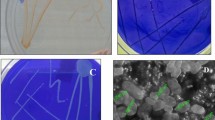Summary
A method for cultivatingSpirulina platensis in domestic raw sewage, coupled with pisciculture and water reclamation in an integrated recycling system, has been standardized. The alga is grown in an indigenously designed open-air pilot production unit consisting of 4 concrete basins with a total surface area of 450 m2. The harvesting and processing methods are based on simple filtration and sun drying. Extensive bench and field experiments have made it possible to produce pure blooms of AfricanSpirulina in sewage, using sodium bicarbonate and nitrate, and employing a fertilizing schedule which replenishes nitrogen withdrawn from the medium by the alga. Although urea and several ammoniacal nitrogen sources have been tried, the best source of protein-inducing nitrogen for mass cultivation ofSpirulina appears to be nitric nitrogen.
Similar content being viewed by others
References
Burlew, J.S., ed., Algal culture from laboratory to pilot plant. Carnegie Institution of Washington Publication 600, Washington, D.C. 1953.
Camp, T.R., Water and its impurities. Reinhold, New York 1963.
Carmichael, W.W., ed., The water environment: Algal toxins and health. Plenum Press, New York and London 1981.
Chamorro, G., Toxicological studies onSpirulina alga. UF/MEX/78/048, UNIDO/10.387, 1980.
Chung, Po, Pond, W.G., Kingsbury, J.M., Walker, Jr, E.F., and Krook, L., Production and nutritive value of Arthrospira platensis, a spiral blue-green alga grown on swine wastes. J. Anim. Sci.47 (1978) 319–330.
Clément, G., Production et constituants caractéristiques des algues Spirulina platensis et maxima. Ann. Nutr. Alim.29 (1975) 477–488.
Clément, G., Une nouvelle ressource: l'algue Spiruline. Soc. Phycol. France, Bull. No. 23 (1978) 57–61.
Clément, G., Giddey, C., and Menzi, R., Amino acid composition and nutritive value of the alga Spirulina maxima. J. Sci. Fd Agric.18 (1967) 497–501.
Durand-Chastel, H., Production and use ofSpirulina in Mexico, in: Algae Biomass, pp. 51–64. Eds G. Shelef and C.J. Soeder. Elsevier/North-Holland Biomedical Press, Amsterdam 1980.
Durand-Chastel, H., and Clément, G.,Spirulina algae: food for tomorrow, in: Proc. 9th Int. Congr. Nutrition, Mexico 1972, vol. 3, pp. 85–90. Eds A. Chavez, H. Bourges and S. Basta. S. Karger, Basel 1975.
FAO/WHO, Energy and protein requirements. Rept. Joint FAO/WHO Ad Hoc Expert Committee, No. 52. FAO, Rome 1973.
Farrar, W.V., Tecuitlatl; a glimpse of Aztec food technology. Nature, Lond.211 (1966) 341–342.
Faucher, O., Coupal, B., and Leduy, A., Utilization of seawater-urea as a culture medium forSpirulina maxima. Can. J. Microbiol.25 (1979) 752–759.
Goldman, J.C., Outdoor algal mass cultures — I. Applications. Water Res.13 (1979) 1–19.
Kosaric, N., Nguyen, H.T., and Bergougnou, M.A., Growth ofmaxima on cow-manure wastes. Biotechnol. Bioengng21 (1979) 2169–2173.
Léonard, J., The 1964–65 Belgian Trans-Saharan expedition. Nature, Lond.209 (1966) 126–128.
McGarry, M.G., Unicellular protein production using domestic wastewater. J. agric. Sci.4 (1971) 213–223.
Oron, G., Shelef, G., and Levi, A., Growth ofSpirulina Spirulina maxima algae in effluents from secondary wastewater treatment plants. Biotechnol. Bioengng16 (1974) 881–896.
Richmond, A., and Vonshak, A.,Spirulina culture in Israel. Arch. Hydrobiol.11 (1978) suppl. Ergebn. Limnol., 274–280.
Santillan, C., Mass production ofSpirulina. Experientia38 (1982) 40–43.
Saxena, P.N., Ahmad, M.R., Shyam, R., and Amla, D.V., Biotechnology ofSpirulina cultivation in sewage. Extension Literature No.4, Economic Botany Information Service, National Botanical Research Institute, Lucknow, India 1981.
Seshadri, C.V., Thomas, S., Manoharan, R., Jeeji Bai, N., and Raja, G., Mass culture ofSpirulina fusiformis. Shri AMM Murugappa Chettiar Research Centre, Madras 1980.
Soong, P., Production and development ofChlorella andSpirulina in Taiwan, in: Algae Biomass, pp. 97–113. Eds G. Shelef and C.J. Soeder. Elsevier/North-Holland Biomedical Press, Amsterdam 1980.
Author information
Authors and Affiliations
Additional information
Acknowledgments. We are grateful to Mr Lee St. Lawrence, WS Atkins Group Consultants, Epsom, England, for the microbiological analysis, and to Dr H.K. Srivastava, Animal Husbandry Department, Uttar Pradesh, for his invaluable help with the feeding experiments.
NBRI Research Publication No. 192 (NS).
Rights and permissions
About this article
Cite this article
Saxena, P.N., Ahmad, M.R., Shyam, R. et al. Cultivation ofSpirulina in sewage for poultry feed. Experientia 39, 1077–1083 (1983). https://doi.org/10.1007/BF01943117
Published:
Issue Date:
DOI: https://doi.org/10.1007/BF01943117




